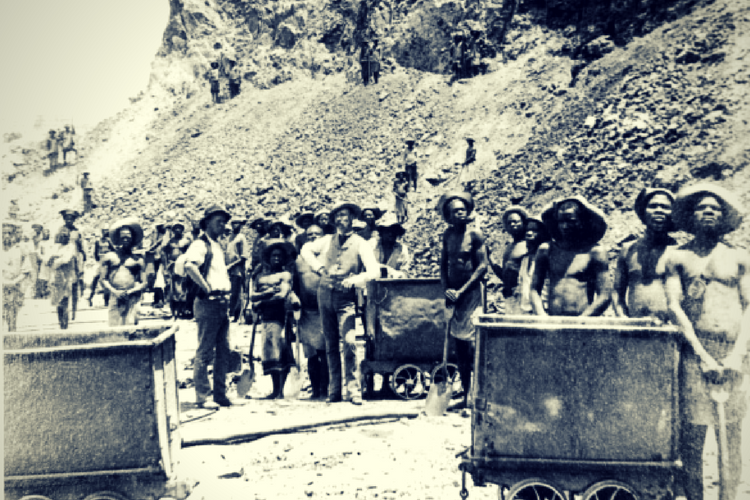RHODES AND CREATION OF DEBEERS FROM 1870
The Kimberly mines were the foundation for racial segregation and black labor exploitation in South Africa. Many mine owners were unhappy with the limited pool of labor and the increase in wages as demand was significantly higher than the market could supply. In 1872, they were 1600 diamond claim holders at Kimberly but by 1877, they were only about 300 and by 1879, they were about 12partnerships/ private companies that controlled almost three quarters of diamond production at Kimberly. This was in part due to the Claim Limitation Law of 1876 which ended small independent diamond production and created a new era of highly capitalized diamond production.
By the 1880s, De Beers had seized control of Kimberly mine through devious takeovers, buyouts and consolidations. In March 1888, the De Beers Consolidated Mines Limited was incorporated as a major holding company and by 1891; they had a monopoly over diamond trade at Kimberly. De Beers was created by Cecil John Rhodes. Rhodes had obtained a Trust Deed which permitted his company to engage in any business enterprise, to annex land in any part of Africa and to govern foreign territories and maintain armies in those territories if necessary. He appointed Life Governors who would control De Beers throughout the duration of their lives. The governors were Alfred Beit, Barney Banato, and Frederick Thomas Phillipson Stow. De Beers quickly became one of the most profitable companies in the world.
LABOR SHORTAGES AND EXPLOITATION
 However, they were still labor shortages at Kimberly, so they introduced laws to force more Africans into the mining labor market. In November, 1876, white farmers were granted land holding rights in Griqualand West. African populations were moved to crowded areas that would force them to seek employment in the mines. Hut tax and later poll tax was imposed on Africans which forced many to seek employment on farms and in the mines. However, the demand for labor at Kimberly still outpaced supply, until they sought the help of Joao Albasini- an old Portuguese slave dealer who promised to recruit workers as far as 1600km away up to the Mozambican coast.
However, they were still labor shortages at Kimberly, so they introduced laws to force more Africans into the mining labor market. In November, 1876, white farmers were granted land holding rights in Griqualand West. African populations were moved to crowded areas that would force them to seek employment in the mines. Hut tax and later poll tax was imposed on Africans which forced many to seek employment on farms and in the mines. However, the demand for labor at Kimberly still outpaced supply, until they sought the help of Joao Albasini- an old Portuguese slave dealer who promised to recruit workers as far as 1600km away up to the Mozambican coast.
Africans were promised wages, food, protection and safety but once they arrived they were subjected to deplorable conditions. Work conditions at Kimberly were similar to slavery. In August 1879, the Labor Commission introduced ‘Localization’, which created closed living quarters for mine laborers. Through localization, 22 000 Africans were forced to live in seven locations which limited their interaction with the outside community. After localization, the Labor Commission granted employers the right to reduce wages to 10 shillings per week. Africans were further sidelined through the Diamond Trade Act of 1882. Through this law, anyone found in possession of a diamond was guilty until proven innocent and was to be denied a jury trial. If convicted by a judge, one would be punished with 15 years in prison, £1,000 fine and if the perpetrator was African they could be whipped.
EARLY PRISON INDUSTRIAL COMPLEX
In spite of these efforts, labor shortages continued at Kimberly, until they sought another method, imprisonment and forced labor. In 1882, the average police officer made about 45 arrests, however, at Kimberly, they arrested between 114 and 160 people. The number of inmates at Kimberly was about seven times higher than in other parts of the country. Once they realized they could exploit prison labor, De Beers Mining Company signed an agreement with the state to establish private prisons were inmates could be used as mine labor. De Beers continued until 1932 which further increased their profitability.
By 1889, Africans who were not in prisons were housed in closed compounds in the seven locations established at Kimberly. African laborers were paid a wage but forced to buy food and supplies from the compound store owned by De Beers. Laborers were closely monitored in those compounds and could not leave until their contract had ended.
PRESENT DAY
In South Africa, De Beers Consolidated Mines Company controls the primary South African sources of diamonds, including seven large diamond mines around the country and De Beers operations accounted for about 94% of the nation’s total diamond output. In Botswana, the Diamond Trading Company Botswana (DTC Botswana) is a 50/50 Joint Venture partnership between the Government of the Republic of Botswana and De Beers Group.





2 responses to “Black Labor Exploitation by Rhodes & De Beers from 1870”
we blacks need to advance our indigenous civilization. we cannot continue to cry oppression, decades after…
We must learn about our history so that we don’t admire our oppressors. We must be aware of things that happened in the past because they shape the future. This kind of labor exploitation was the foundation for the way black miners are still being treated. The miners at Marikana were not viewed as human thats why they were abused.